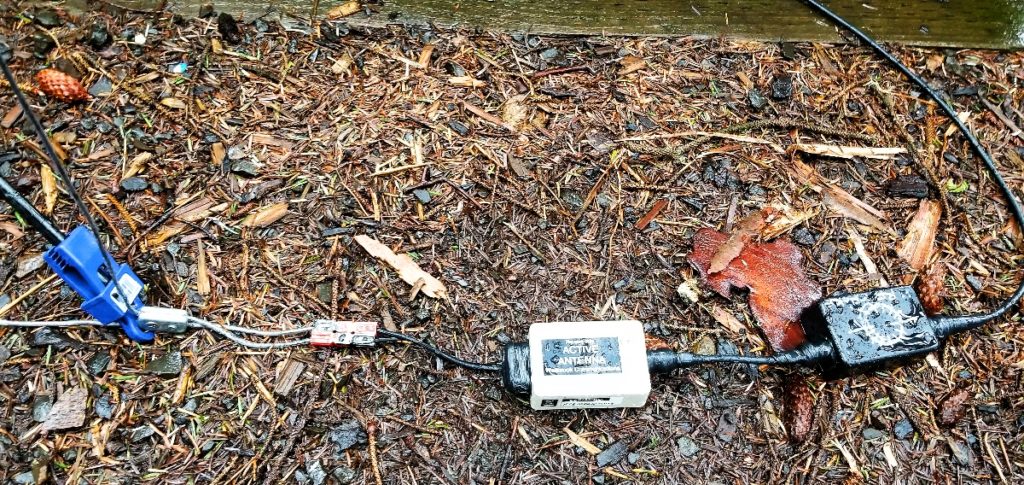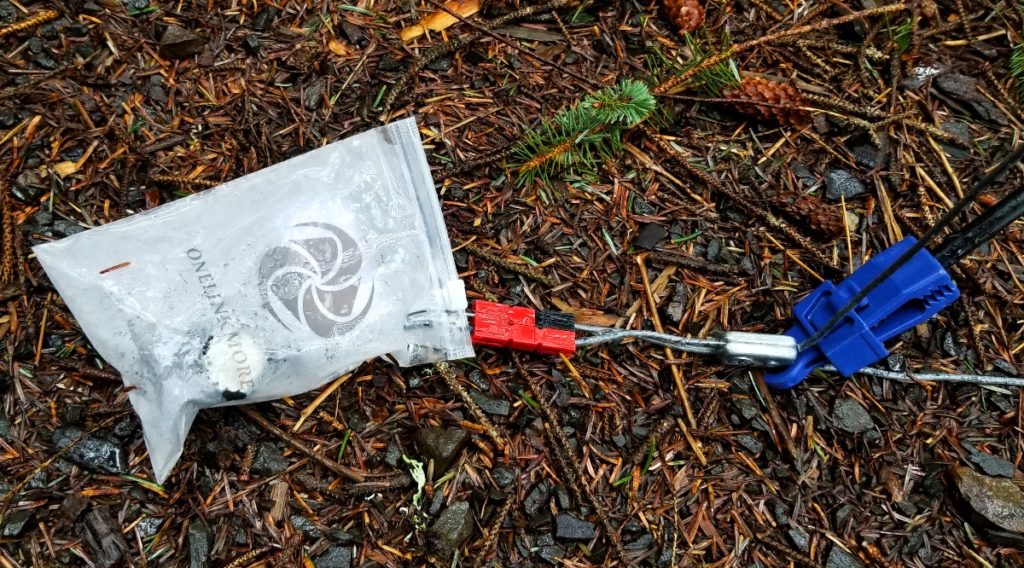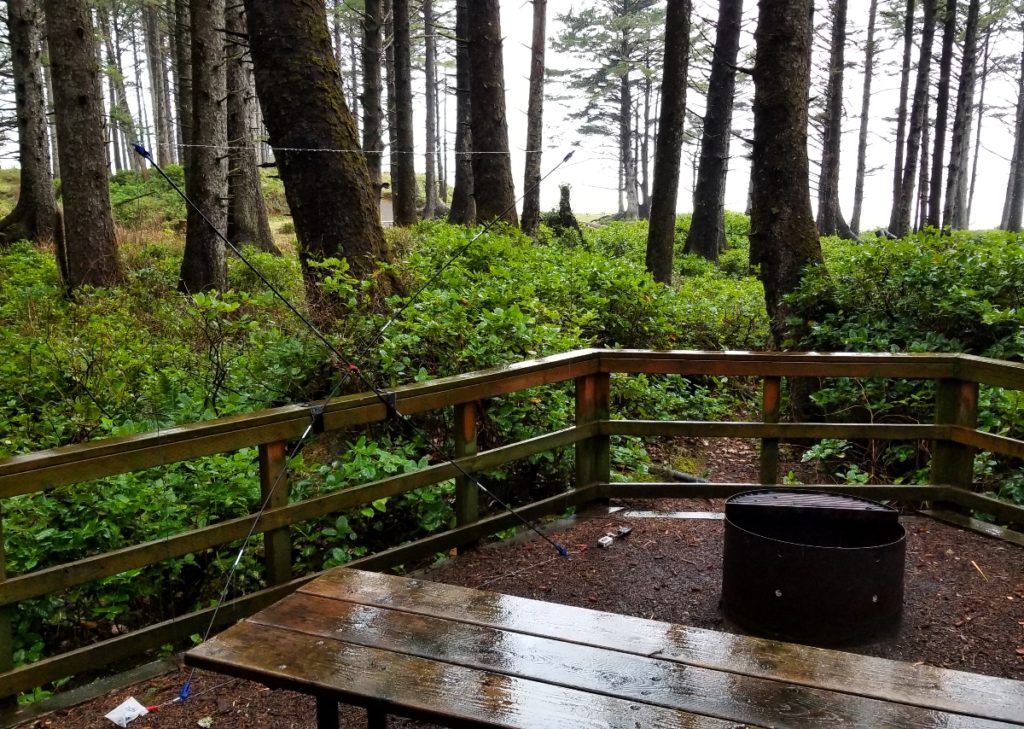I’m currently spending the better part of a week at Cape Lookout State Park on the Oregon coast, with a great view of the ocean through tall evergreen trees. This is one of my favorite parks in the Pacific Northwest, especially when DXing during the blustery winters from one of the nice cabins at Cape Lookout.
The view from the beach near my cabin; the turbulent waves were a precursor to the gale force winds at the park during the night of the 23rd!
https://youtu.be/EYUSU_gzgu4
Although I’m at the park for trans-Pacific medium wave DXing, I’m also comparing receivers, both SDRs and portables. This morning I sought out a few weak shortwave signals, pitting the Elad FDM-S2 SDR ($529 USD) against the AirSpy HF+ ($199 USD). I have a pair of the HF+ receivers to cover all of medium wave (as the FDM-S2 easily does). Many SWLing Post readers already know that the upstart HF+ trades bandwidth to gain high performance in order to keep the price reasonable.
My antenna used for the following recordings was a small “Flag” antenna using a Wellbrook Communications FLG100LN module and a 2K ohm variable potentiometer for termination. The design uses crossed tent poles in an “X” formation to support the wire loop. This design travels easily in a compact package; I have Dave Aichelman of Grants Pass, Oregon to thank for this very useful “tent pole loop” implementation of the Wellbrook FLG100LN.
The Wellbrook-based antenna functions superbly, and its low-noise design helps hold down QRM from the nearby cabins (which unfortunately have been “upgraded” recently with noisy cold fluorescent [CFL] light bulbs). The area around the Cape Lookout cabins used to be superbly low noise and suitable for radio listening, but now it is more of a challenge than before. The Wellbrook FLG100LN is perfect for the situation though; Wellbrook ALA1530LN Pro and ALA1530S+ 1-meter loop antennas work commendably at the park too.
The Wellbrook FLG100LN module with a home brew RFI choke in-line
A 2K ohm variable potentiometer is protected from the elements in a small plastic bag. The “pot” is adjusted for the best nulling of medium wave stations off the back side of the antenna’s reception pattern.
The “tent pole loop” antenna is strapped to a fence railing with ultra-strong Gorilla Tape to keep the 7-ft. square loop vertical.
On with the recordings…
For the FDM-S2 and HF+ comparisons I used the SDR-Console V3 software. Every parameter was identical for the receivers–sampling bandwidth, filter bandwidth, AGC, mode and so on.
Take a critical listen to the weak signals recorded with the SDR receivers, identified as only “Radio A” and “Radio B”. A link to a poll is at the end of this article; please indicate which recording of each pair has the most intelligible audio in your opinion, and submit your choices when you’ve made up your mind on each audio clip. After a week or so I’ll post the results of the voting, and identify the receivers.
9.615 MHz, LSB, Radio A
9.615 MHz, LSB, Radio B (note: the same male announcer heard in clip “A” begins at 00:14 in this “B” clip)
9.730 MHz, USB, Radio A
9.730 MHz, USB, Radio B
7.230 MHz, S-AM, Radio A
7.230 MHz, S-AM, Radio B
9.860 MHz, S-AM, Radio A
9.860 MHz, S-AM, Radio B
Note on 7.230 MHz recording: this was an interesting frequency, as the signal was tightly surrounded by a very strong local 40m ham radio LSB station as well as a strong China Radio International signal. There were other strong amateur and broadcast stations within 30-50 kHz of 7.230 MHz, also. This A-B test more than the others may indicate receiver performance in a strong RF environment on a crowded band.
Ready for the poll? Register your votes at the Google Docs form below:
In a week to 10 days I’ll post the results in another article. NOTE: I haven’t provided a “both sound the same” choice in the poll to encourage you to ‘dig deep’ into the audio and listen critically–to find something that stands out in one clip versus the other.
Guy Atkins is a Sr. Graphic Designer for T-Mobile and lives near Seattle, Washington. He’s a regular contributor to the SWLing Post.




Wow, surprised that you can get 840 AM in Tacoma……..I used to drive all over the Oregon and Washington Coast and did not think that their reception went much past the Long Beach peninsula. When I picked them up in Lincoln City I thought it was some kind of achievement! They are streaming online now but I think that they merged their AM/FM channels, not sure. I used to love listening to them 10 years ago when they had Les Michaels and Damage as DJ’s. Turns out that they were the same person……..or one was the alter ego of the station manager. It was very confusing but excellent Radio. Turns out Les Michaels was actually the same guy that is “UFO Phil”.
You should seek out 840 AM out of Seaside. A great local station with a very eclectic mix of oldies. I have heard them as far South as Lincoln City but only in select places. Also in Pacific City which is close to your camp? And yes, the Oregon/Washington Coast is pretty and picturesque, but to a lifelong Oregonian I can take it or leave it as there are very few days during the year where it is actually enjoyable being there!
Hi Luke,
Ah yes, KSWB 840… my source for “good times oldies” up and down the northern Oregon coast! I know this station well, and have seen their tower in Seaside. I tune them in regularly when I’m camping in Nehalem, south of Cannon Beach/Seaside. I’m closer to Tillamook now though, and KTIL 1590 has a stronger signal with Oldies and local news at this location at Cape Lookout.
Sometimes I can hear KSWB from my home east of Tacoma, Washington in the early evenings; I can hear the station about half of the time I try for them. Another favorite I try for from home is CJDC, Dawson Creek, BC Canada. I’m amazed at how well CJDC can be received in my area on occasion.
Very interesting comparisons, Guy. What I like about this is that you made every effort to keep the external variables the same for each recording. I hate it when people make recording/YouTube videos, trying to compare two radios with different antennas, different volume settings, different tone settings, etc, etc. Those types of comparisons are pointless! Thanks – I’m looking forward to the poll results. Rob VK3BVW
I cannot complete the poll as I found all clips identical except the first one, in which I found B better. The rest sounded the same. The poll will not allow this result.
Hi Andy, I agree that each sample is very close to the other! I think this says something about the two receivers :^)
I didn’t provide a “both sound the same” choice in the poll to encourage listeners to ‘dig deep’ into the audio and listen critically to find something that stands out in one clip versus the other.
Admittedly, this article and the recordings are of real interest only to those DXers who are intrigued by signals close to the noise floor. Hope springs eternal while listening to weak stations like these…will they get stronger and reveal a rare DX catch?… or not!
Best wishes, Guy
First of all, what a GORGEOUS part of the world! I love the rugged coast, winds and waves!
Secondly, I love this sort of survey! Brilliant!
I’m going to listen via my Bose noise-cancelling phones to isolate other noises.
Cheers,
Thomas
Yes, this is a rugged, beautiful part of the country, Thomas! You should plan a trip out this way sometime (hint hint :^) .
The audio clips are extremely similar. I didn’t say it would be easy!